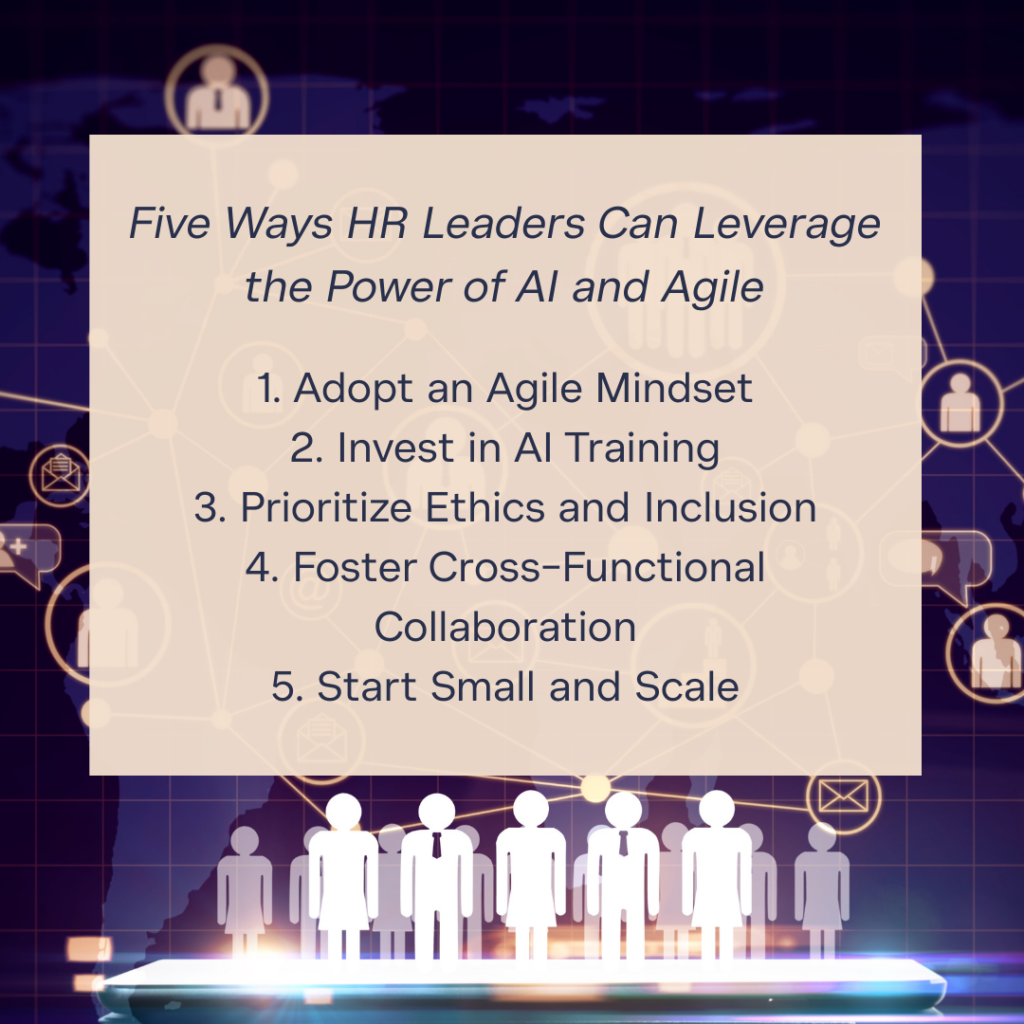In today’s rapidly evolving business world, organizations face unprecedented challenges and opportunities. Two transformative forces—Agile methodologies and Artificial Intelligence (AI)—are reshaping industries, and the synergy between them holds great potential. This is especially true for human resource (HR) leaders. Understanding how Agile and AI intersect and complement each other can enable HR leaders to drive innovation, foster adaptability and enhance workforce experiences both now and in the future.
Agile and AI: A Brief Overview
- Agile Methodologies: Agile is a project management and operational framework focused on iterative development, collaboration and responsiveness to change. Originally designed for software development, Agile principles—like adaptability, incremental progress, and stakeholder collaboration—have since been adopted across various business functions, including HR.
- Artificial Intelligence: AI refers to technologies that mimic human thinking, including machine learning, natural language processing, and predictive analytics. AI helps organizations analyze large datasets, automate repetitive tasks and provides users with fast, accurate insights.
When combined, Agile and AI create a dynamic duo: Agile provides the framework for adaptability, while AI delivers data-driven insights and efficiency. Together, they help HR leaders create a more resilient and forward-thinking workforce.
Current Applications of Agile and AI in HR
- Talent Acquisition and Recruitment:
- AI-driven tools, such as applicant tracking systems (ATS) and candidate matching algorithms, streamline hiring.
- Agile principles help HR teams iterate on recruitment strategies based on feedback and performance metrics. This ensures alignment with company goals.
- Employee Engagement and Experience:
- AI-powered chatbots provide 24/7 support for employee queries, enhancing the employee experience.
- Agile frameworks encourage HR teams to collect and act on employee feedback, fostering a culture of improvement.
- Learning and Development:
- AI customizes training by analyzing individual skill gaps and career goals.
- Agile learning—a just-in-time, flexible approach to upskilling—ensures that employees stay relevant in fast-changing environments.
- Workforce Planning:
- Predictive analytics powered by AI enables HR leaders to predict hiring needs and skill shortages.
- Agile methodologies facilitate adjustments to workforce plans based on real-time insights.
The Future of Agile and AI in HR
As organizations continue to embrace digital transformation, the collaboration between Agile and AI will deepen. Here are some emerging trends HR leaders should watch:
- Hyper-Personalization:
- AI will enable highly personalized employee experiences, from onboarding to career development. Agile methodologies will ensure these initiatives are iterative and aligned with evolving employee expectations.
- AI-Augmented Decision Making:
- AI will provide HR leaders with predictive and prescriptive insights. This enables better decision-making in hiring, retention, and performance management. Agile frameworks will allow teams to implement these insights quickly and effectively.
- Continuous Workplace Improvement:
- AI tools will provide real-time data on workforce productivity and engagement. Agile principles will ensure this data is used to make iterative improvements rather than reactive changes.
- Human-Centric AI Development:
- Agile’s emphasis on collaboration and stakeholder involvement will be crucial in developing AI tools that prioritize employee wellbeing and fairness.
How HR Leaders Can Harness Agile and AI

To fully leverage the power of Agile and AI, HR leaders should:
- Adopt an Agile Mindset:
- Embrace flexibility, collaboration and continuous improvement in HR processes.
- Invest in AI Training:
- Equip HR teams with the skills to understand and use AI tools effectively.
- Prioritize Ethics and Inclusion:
- Ensure AI systems are free from bias and support diverse and equitable workplaces.
- Foster Cross-Functional Collaboration:
- Partner with IT, data science and business teams to integrate AI and Agile practices into HR operations.
- Start Small and Scale:
- Use pilot projects to experiment with Agile-AI initiatives and scale successful strategies organization-wide.
Practical Use Case: Transforming Recruitment with Agile and AI
Scenario: A fast-growing tech company, InnovateX, is struggling to fill critical roles in data science and software engineering. Their traditional recruitment process is slow and inefficient, failing to attract top talent.
Challenge:
- Long time-to-hire.
- High dropout rates during the application process.
- Difficulty identifying the best candidates from large applicant pools.
Solution:
- AI Integration:
- InnovateX implements an AI-powered recruitment platform that screens resumes and ranks candidates based on job requirements. It uses historical hiring data to predict if a candidate will be a good fit.
- Chatbots handle initial candidate queries, ensuring a smooth application experience and freeing up recruiters’ time.
- Agile Framework:
- The HR team adopts an Agile approach to recruitment. They run two-week sprints to review and refine the hiring process, using feedback from hiring managers and candidates.
- Metrics such as time-to-hire, candidate satisfaction and diversity benchmarks are tracked and iterated upon.
Outcome:
- Time-to-hire reduces by 40%.
- Candidate satisfaction scores improve by 30%.
- The company successfully fills 95% of roles within three months.
Key Takeaway: By combining AI’s efficiency with Agile’s adaptability, InnovateX creates a recruitment process that is fast, data-driven and candidate-focused.
Conclusion
The convergence of Agile and AI represents a transformative opportunity for HR leaders. By blending Agile’s adaptability with AI’s intelligence, organizations can create resilient, innovative and people-centric workplaces. As these technologies continue to evolve, HR leaders who embrace their synergy will be at the forefront of driving organizational success in the face of change. Now is the time to act, experiment and lead the way into a smarter, more agile future.





